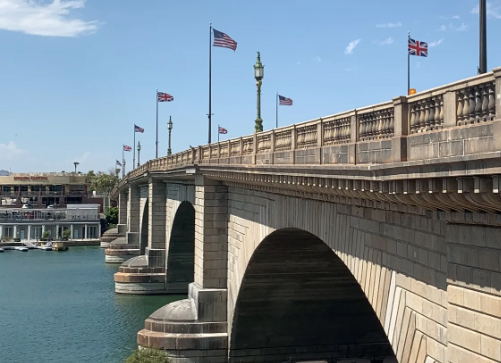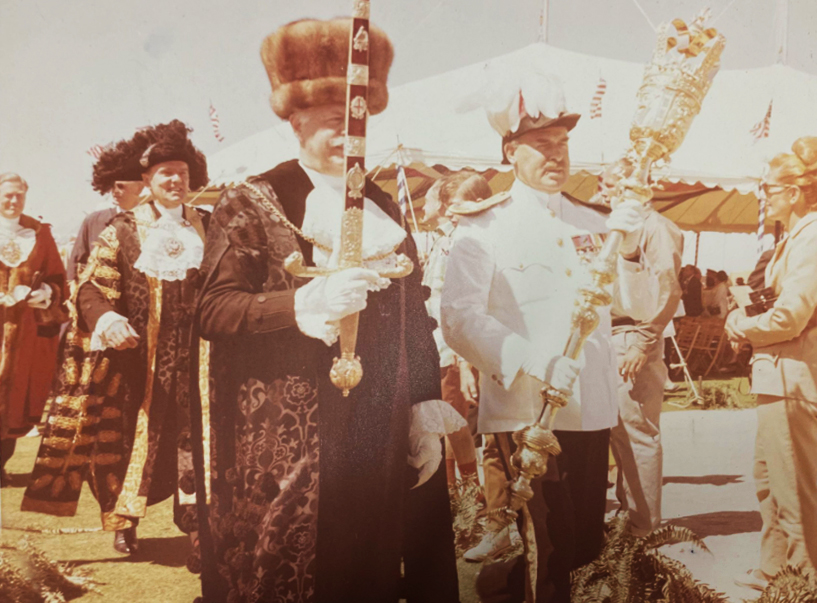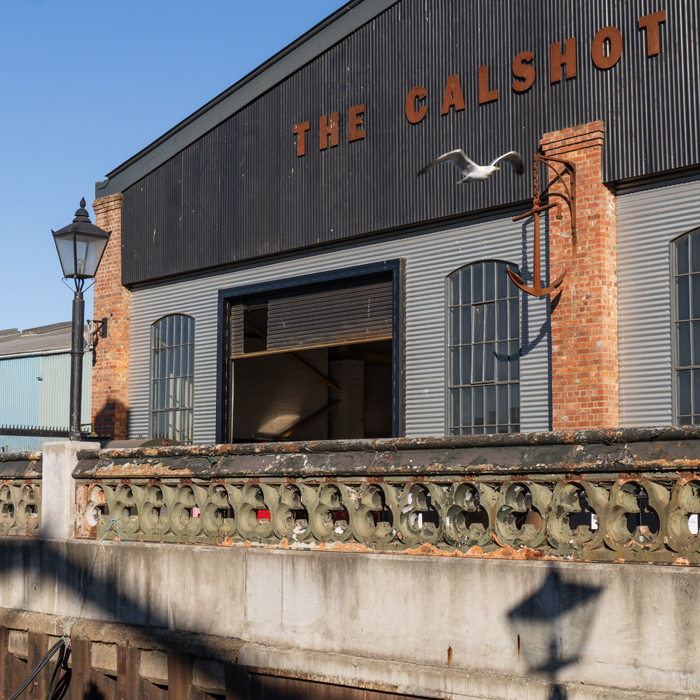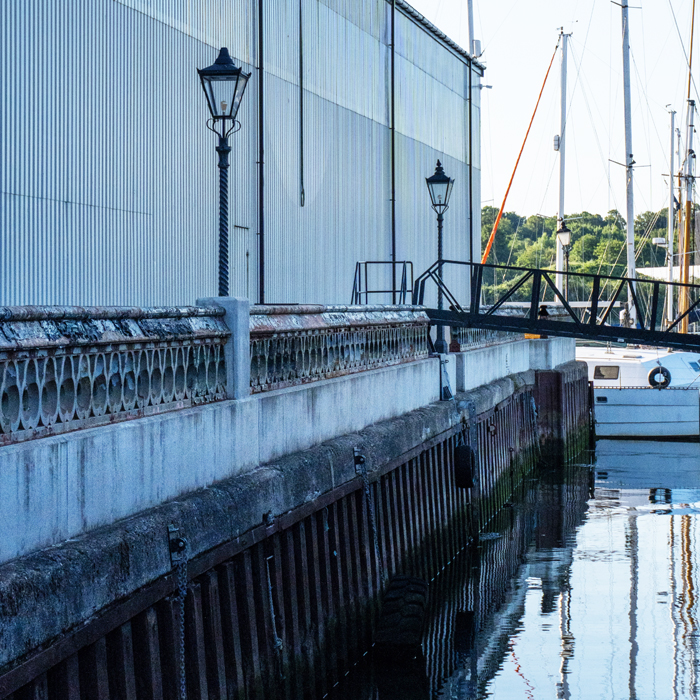A Bridge across the Atlantic
On the morning of 9th October 1971 the Lord Mayor of London, Sir Gilbert Inglefield, together with a party of dignitaries, sat in the front row of chairs laid out in a marquee on London Bridge listening to speeches. They were dressed in all their finery: frock coats with the chains of office about their necks, beaver-skin hats on their heads and stockings and buckled shoes on their feet. They were probably quite hungover as they had attended a spectacular banquet and carnival there the night before.

In all their finery the London dignitaries were extremely hot. As the formalities began the October temperature was already over 90degrees. This was because they were not sat above the Thames in central London, they were on the edge of the Mojave Desert in Arizona. They were guests of Robert McCulloch (1911-77), the man who had bought the salvaged London Bridge from The Corporation of London and had it shipped to America as a showpiece in his great project: Lake Havasu City. The new city was being built from scratch alongside an artificial lake (created in previous decades in order to supply water to Los Angeles 300miles away). Robert McCulloch’s city centre – the downtown – was to occupy an isthmus and the neck of that isthmus needed to have a large bridge. The ceremony and festivities that weekend, for which the Lord Mayor and his team were flown over, were to re-dedicate the 140year old London Bridge and formally declare it open in its new home.

McCulloch was an oil baron from Missouri and was known as “The Chainsaw Millionaire”. The drive to build a city alongside the lake was sparked by his desire to diversify his core business manufacturing chainsaws, to now include making outboard engines. His business had outgrown the factories in Los Angeles and had no proximate freshwater lakes on which to develop and test the engines; so he determined to sell the factories by LAX airport and build afresh, relocating to a 40square mile swathe of desert that he bought in Arizona. It was certainly a bold plan.
An “urban myth”, often still repeated today, originated at that very opening ceremony: that “the Americans thought that they had bought Tower Bridge!”; English wags recount this story with glee, but it isn’t true. The joke was actually coined by McCulloch himself in his speech to the sweating London dignitaries sitting there in their ermine that morning: “We thought we were buying Tower Bridge – the one that does that!!”(levers his hands – everybody laughed).
London Bridge, as built by John Rennie (and sons) in 1831, dismantled by 1968 and shipped to Lake Havasu, is still there today. It looks magnificent in the desert sunshine. Comprising 10,000tonnes of Scottish and Dartmoor granite (applied to new concrete spans) it is certainly the largest singular salvaged architectural structure to cross the Atlantic. But now it isn’t the only historic bridge from London to make the trip.
On Tuesday this week (2nd July 2025), 53years since the London Bridge ceremony, in a more modest opening celebration, but one brimming with gratitude, pride and thanksgiving, a happy band of dignitaries and islanders gathered at the new Ferry Terminal on the tiny Caribbean island of Canouan. After speeches, awards and music the small throng made their way to the seaward entranceway between a long run of Victorian iron balustrades that now front the new terminus complex – and they cut the ribbon declaring it open. That balustrade is the magnificent ironwork from Westminster Bridge built in 1862 by Thomas Page (1803-77) and Sir Charles Barry (1795-1860) and designed to match Pugin’s then new, gothic Palace of Westminster. (The iron parapet on the bridge today is a 1997 copy).

What is truly remarkable is that this opening ceremony has been held only a year to-the-day since Hurricane Beryl laid waste to the island. The category 5 super-storm barrelled across the Southern Grenadines on 2nd July 2024 and each island it encountered in its path was devastated.
As Beryl howled off into the Gulf of Mexico, the residents picked themselves up and surveyed the wreckage. They were very lucky to have in their number a benefactor with the resources and expertise to re-establish and re-construct the destroyed ferry terminal – vital infrastructure. And he happened to have bought from LASSCO ten truck-loads of the Westminster ironwork with which to embellish the restoration.
The new ferry terminal complex has been created, wherever possible, from materials salvaged from the wreckage of the hurricane. It has been designed in the local vernacular and the buildings are corralled together with the long, protective, iron parapet, cut with its distinctive trefoils. As with the granite London Bridge in the Arizona desert, the iron Westminster Bridge looks tremendous in the Caribbean sunshine.

That benefactor, who prefers not to be named here, had bought all of the Westminster Bridge ironwork from LASSCO Three Pigeons in Oxfordshire (about 185tonnes in total and measuring over 330 running meters) and initially installed a long run of it fronting his commercial property, a quayside on Southampton Water in Hampshire. It worked beautifully there – dropping into place on an existing low concrete sea-defence wall. Always with plans to utilise the ironwork on a couple of other projects, the havoc of Hurricane Beryl modified his intentions. After this rapid restoration at Canouan as well as the neighbouring island Mayreau, where the bridge has been used in a similar ferry-port design, there are plans underway to incorporate the ironwork at other island ferry-ports in the Grenadine chain as re-building work continues. He comments:
“I felt it was appropriate in the rebuilding to use the bridge as well as materials that came from the devastation of the hurricane which were repurposed. With this everyone carries the scars with pride and positivity that from this disaster came a rebirth.”

Blog post Written by: Anthony Reeve, LASSCO Three Pigeons, Oxfordshire
Thank you to: Dean Thomas for the photos of the bridge ironwork as installed near Southampton.
For the full story of how London Bridge got to Arizona read: Travis Elborough’s “London Bridge in America” Vintage 2014.
“A Bridge across the Atlantic” is the fourth blog post from a series which normally starts with the following paragraph:
If there’s a recurring question from customers – agog at the glorious salvage crammed into the LASSCO shops and yards in Oxfordshire and London – it is “Where do you get all this stuff from?”. Another is “Who is going to buy that?”. Sometimes we can answer that and tell you the whole story:
The first was “The Tale of the Asylum Railing”,
The second was “The 12th Johnson Hobby Horse”.
The third was “Island Life”
